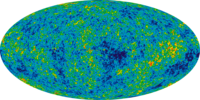
Photo from wikipedia
Accurate scatter estimation is important in quantitative SPECT for improving image contrast and accuracy. With a large number of photon histories, Monte-Carlo (MC) simulation can yield accurate scatter estimation, but… Click to show full abstract
Accurate scatter estimation is important in quantitative SPECT for improving image contrast and accuracy. With a large number of photon histories, Monte-Carlo (MC) simulation can yield accurate scatter estimation, but is computationally expensive. Recent deep learning-based approaches can yield accurate scatter estimates quickly, yet full MC simulation is still required to generate scatter estimates as ground truth labels for all training data. Here we propose a physics-guided weakly supervised training framework for fast and accurate scatter estimation in quantitative SPECT by using a 100× shorter MC simulation as weak labels and enhancing them with deep neural networks. Our weakly supervised approach also allows quick fine-tuning of the trained network to any new test data for further improved performance with an additional short MC simulation (weak label) for patient-specific scatter modelling. Our method was trained with 18 XCAT phantoms with diverse anatomies / activities and then was evaluated on 6 XCAT phantoms, 4 realistic virtual patient phantoms, 1 torso phantom and 3 clinical scans from 2 patients for 177Lu SPECT with single / dual photopeaks (113, 208 keV). Our proposed weakly supervised method yielded comparable performance to the supervised counterpart in phantom experiments, but with significantly reduced computation in labeling. Our proposed method with patient-specific fine-tuning achieved more accurate scatter estimates than the supervised method in clinical scans. Our method with physics-guided weak supervision enables accurate deep scatter estimation in quantitative SPECT, while requiring much lower computation in labeling, enabling patient-specific fine-tuning capability in testing.
Journal Title: IEEE transactions on medical imaging
Year Published: 2023
Link to full text (if available)
Share on Social Media: Sign Up to like & get
recommendations!